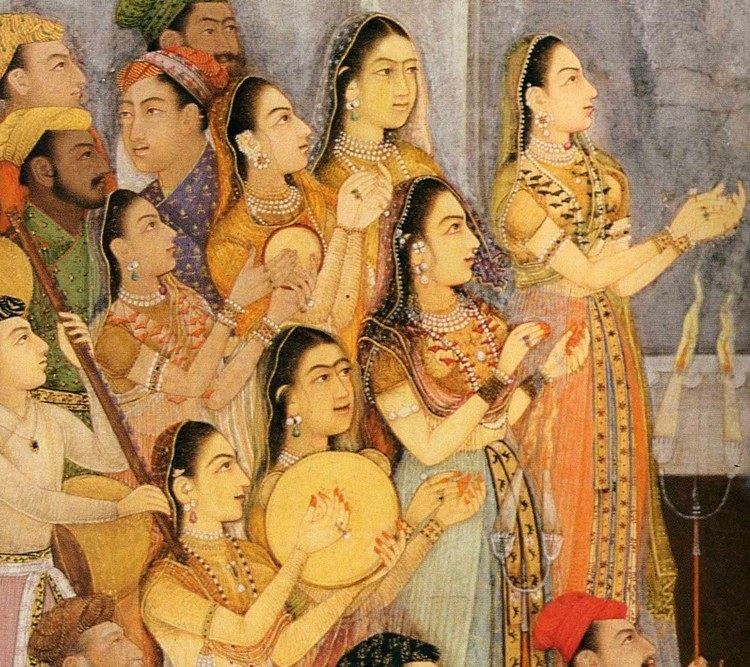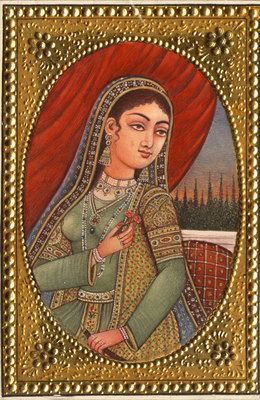Name Dilras Begum Father Shah Nawaz Khan Safavi | Religion Islam | |
 | ||
Issue Zeb-un-NissaZinat-un-NissaZubdat-un-NissaAzam Shah, Mughal EmperorSultan Muhammad Akbar House House of Safavi (by birth)House of Timur (by marriage) Died October 8, 1657, Aurangabad Parents Mirza Badi-uz-Zaman Safavi Children Muhammad Azam Shah, Zeb-un-Nisa, Zinat-un-Nissa, Sultan Muhammad Akbar, Zubdat-un-Nissa Similar People Aurangzeb, Muhammad Azam Shah, Zeb‑un‑Nisa, Bahadur Shah I, Murad Bakhsh | ||
Mausoleum of dilras banu begum bibi ka maqbara
Dilras Banu Begum (Persian: دلرس بانو بیگم, Urdu: دلرس بانو بیگم) (c. 1622 – 8 October 1657) was the first wife and chief consort of Emperor Aurangzeb, the last of the great Mughal emperors. She is also known by her posthumous title, Rabia-ud-Daurani ("Rabia of the Age"). The Bibi Ka Maqbara in Aurangabad, which bears a striking resemblance to the famous Taj Mahal (the mausoleum of Aurangzeb's mother Mumtaz Mahal), was commissioned by her husband to act as her final resting place.
Contents
- Mausoleum of dilras banu begum bibi ka maqbara
- Popular Videos Bibi Ka Maqbara Dilras Banu Begum
- Family and lineage
- Marriage to Aurangzeb
- Issue
- Death and aftermath
- Bibi Ka Maqbara
- In popular culture
- References

Dilras was born a princess of the prominent Safavid dynasty of Iran (Persia), and was a daughter of Mirza Badi-uz-Zaman Safavi (a descendant of Shah Ismail I) and his wife, Nauras Banu Begum. She married Prince Muhi-ud-din (later known as 'Aurangzeb' upon his accession) in 1637 and bore him five children, including: Muhammad Azam Shah (the heir apparent anointed by Aurangzeb), who temporarily succeeded his father as Mughal emperor, the gifted poetess Princess Zeb-un-Nissa (Aurangzeb's favourite daughter), Princess Zinat-un-Nissa (titled Padshah Begum), and Sultan Muhammad Akbar, the Emperor's best loved son.
Dilras died possibly of puerperal fever in 1657, a month after giving birth to her fifth child, Muhammad Akbar, and just a year before her husband acceded to the throne after a fratricidal war of succession.
Popular Videos - Bibi Ka Maqbara & Dilras Banu Begum
Family and lineage
Dilras Banu Begum was born a princess of the prominent, Safavid dynasty, the ruling dynasty of Iran (Persia) and one of its most significant ruling dynasties. She was the daughter of Mirza Badi-uz-Zaman Safavi (titled Shahnawaz Khan and popularly known as Mirza Deccan) whose great-grandfather was the son of Shah Ismail I Safavi. Shahnawaz Khan was the governor of Gujarat. He loved pomp and grandeur, which was very evident in the lavish and grand marriage celebrations of his daughter, Dilras to Prince Muhi-ud-Din. Dilras' mother, Nauras Banu Begum, was the daughter of Mirza Muhammad Sharif, while her father was a son of Mirza Rustam Safavi, who rose to eminence during Emperor Jahangir's reign.
In 1638, Dilras' younger sister, Sakina Banu Begum, married Aurangzeb's youngest brother, Prince Murad Baksh. This marriage further strengthened the ties between the imperial family and Shah Nawaz Khan's family, and as an extension, the Safavid dynasty.
Marriage to Aurangzeb
Dilras married Prince Muhi-ud-Din (later known as 'Aurangzeb' upon his accession) on 8 May 1637 at Agra; he was the third son of Emperor Shah Jahan and his wife Mumtaz Mahal. The marriage proposal was put forth by Shah Jahan and was accepted by Dilras' father which led to their betrothal. Aurangzeb was lovingly called by the Emperor from the Deccan where he was campaigning and arrived at Agra on 15 April 1637 for his wedding.
As decided by the imperial court astrologers, their marriage ceremony was held at four hours to dawn, amid lavish and grand celebrations and took place at Shahnawaz Khan's mansion. The grandeur of the celebrations are described by chronicler, Khafi Khan, "The burst of fireworks transformed the earth into another sky," and the charms of the singers and dancers would've been the envy "even of Venus." The qazi married the couple in the Emperor's presence, and the mehr was fixed at 400,000 rupees. After the wedding, a reception (walima) was held on 14 May at Aurangzeb's mansion, where Emperor Shah Jahan gave wedding gifts to amirs.
The newly married couple spent more than three happy months at Agra with the Emperor before taking their leave for the Deccan on 4 September 1637, where Aurangzeb was serving as viceroy. During their stay at Agra, Dilras had become pregnant with Aurangzeb's first child: the gifted poet Princess Zeb-un-Nissa. She was born nine months after their marriage on 15 February 1638 at Daulatabad, Deccan, and was her father's favourite daughter. Over the next nineteen years, the imperial couple would have four more children, all of whom were favoured by Aurangzeb above the rest of his children from his secondary wives. As Aurangzeb's chief consort, Dilras wielded considerable influence over him, and ruled his zenana or harem. She was amongst the highest ranked figures at the Mughal court unlike her husband's secondary wives, who were very unpopular at court. However, Dilras did not take part in court politics and in administrative affairs as her husband did not seemed to have allowed even her to interfere in such matters.
Dilras' known physical and personal attributes describe her as being beautiful, vivacious, charming, and fair coloured. Pertaining to her character, she seems to have been a proud and self-willed woman and her husband stood in some awe of her. She was reputed to have been irascible, and was, says Aurangzeb, a woman of "extreme imperiousness, but to the end of her life I continued to love her and never once did I wound her feelings."
Dilras' arrogant nature did not create problems in her marriage, as Aurangzeb always acted humbly with his haughty and imperious wife and had great respect and admiration for her. From all accounts it appears that Dilras was not dissimilar in character to her husband either. Both of them were strong-willed, pious and comparatively indifferent to the normal scheme of material values.
However, whereas Aurangzeb was every inch a fanatical Sunni, Dilras Begum was out and out a satirical Shia. Aurangzeb despised Shias and yet, he allowed Dilras to raise their eldest son, Azam Shah, in this faith. In his court, the prince organized debates between Shia and Sunni ulema in which Princess Zeb-un-Nissa also participated. However, when he became emperor, after Dilras had passed away, Aurangzeb asked his daughter not to participate in these rituals and to renounce all Shia practices, which she did, according to the historian Magan Lal.
Aurangzeb's other marriages to his two secondary wives were meaningless. As a result, these two inferior wives, though they produced four more children for him, remained isolated from their husband. The affection, status, power and authority of being the imperial consort was reserved for Dilras only. She retained her influence over her husband till the end of her life and always remained his favourite as well as his principal consort. Even after her untimely death, her position at court, in the palace, and in her husband's life was not taken by either of his secondary wives. Thus, Dilras was never replaced.
Issue
Dilras' initial pregnancies took place at intervals of at least four years. Professor Annie Krieger-Krynicki states that Aurangzeb may not have wanted to put a strain on her fragile health by imposing too many pregnancies on her frequently, as Shah Jahan, fatally, had done with Mumtaz Mahal. During the course of their twenty years of marriage, the imperial couple became parents of five children:
Death and aftermath
After giving birth to her fifth child, Muhammad Akbar, Dilras possibly suffered from puerperal fever, due to complications caused by the delivery and died a month after the birth of her son. Upon her death, Aurangzeb's pain was extreme and their eldest son, Prince Azam, was so grieved that he had a nervous breakdown. It became Dilras' eldest daughter, Princess Zeb-un-Nissa's responsibility to take charge of her newborn brother. Zeb-un-Nissa doted on her brother a lot, and at the same time, Aurangzeb greatly indulged his motherless son and the prince soon became his best loved son.
Bibi Ka Maqbara
Three years after her death in 1660, Aurangzeb commissioned a mausoleum at Aurangabad to act as her final resting place, known as Bibi Ka Maqbara ("Tomb of the Lady"). It is notable that Aurangzeb never raised monumental edifices during his half-a-century reign, but made just one exception, that is, to build the mausoleum of his wife. Here, Dilras was buried under the posthumous title of 'Rabia-ud-Daurani' ("Rabia of the Age"). The Bibi Ka Maqbara bears a striking resemblance to the famous Taj Mahal, the mausoleum of Dilras' mother-in-law, Empress Mumtaz Mahal, who herself died in childbirth.
Bibi Ka Maqbara was the largest structure that Aurangzeb had to his credit. In the following years, her tomb was repaired by her son, Azam Shah, under Aurangzeb's orders. Aurangzeb, himself, is buried a few kilometers away from her mausoleum in Khuldabad.
